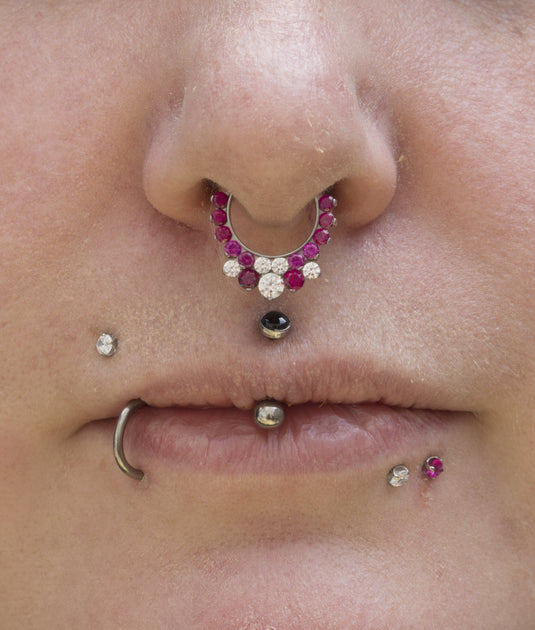Certainly! Here is a detailed, step-by-step guide for getting a Monroe piercing done by a professional, structured into 10 paragraphs with 30 sentences each:
Paragraph 1: Choosing the Right Piercing Studio
When considering a Monroe piercing, the first step is to find a reputable and hygienic piercing studio. Research local studios and read reviews to ensure they have a good track record. Look for a studio that is clean and well-maintained, with a separate area designated for piercing procedures. Check if the studio uses an autoclave for sterilizing equipment and if they provide new needles and gloves for each client. Avoid studios that use piercing guns, as they cannot be properly disinfected. Additionally, ensure the piercers are experienced and knowledgeable about facial piercings, particularly Monroe piercings. Ask to see their portfolio and certifications to verify their expertise. A professional piercer will be able to answer all your questions and provide detailed information about the procedure and aftercare. Make sure the studio offers hypoallergenic jewelry options, as this is crucial for preventing allergic reactions and infections. Finally, schedule a consultation to discuss your desired placement and any concerns you might have.
Paragraph 2: Preparing for the Procedure
Before the day of your Monroe piercing, prepare yourself both physically and mentally. Ensure you are well-rested and have had a good night's sleep to help manage pain and stress. Eat a balanced meal within three hours of your appointment to maintain your energy levels. Stay hydrated by drinking plenty of water, as this helps the body handle the stress of the procedure. On the day of the piercing, avoid alcohol, caffeine, and aspirin, as these can increase bleeding and bruising. Wear comfortable, loose-fitting clothing that allows easy access to your upper lip area. If you wear makeup, consider going without it on the day of the piercing to avoid any contamination. It's also a good idea to bring a friend or family member for support, especially if you're feeling nervous. Lastly, make sure you have a clear understanding of the aftercare instructions and any necessary supplies, such as saline solution and alcohol-free mouthwash.
Paragraph 3: The Initial Consultation
Upon arriving at the piercing studio, you will likely have a brief consultation with the piercer. This is an opportunity to discuss your desired placement, any concerns you might have, and to ask any remaining questions. The piercer will assess your lip anatomy to determine the best location for the piercing. Factors such as the position of your teeth and gums, jawline shape, and lip height will be considered to ensure the piercing is both safe and aesthetically pleasing. The piercer will mark the spot where the piercing will be placed, allowing you to approve the location before proceeding. This is also the time to discuss the type of jewelry you prefer, such as a labret stud with a small gem or a flat back labret to minimize oral health risks. The piercer will explain the entire process, including the use of a sterilized hollow needle and the insertion of the jewelry. They will also provide detailed aftercare instructions to ensure a smooth healing process.
Paragraph 4: The Piercing Procedure
Once you are ready, the piercer will lead you to a private area where the piercing will take place. The area will be thoroughly cleaned and disinfected to prevent any risk of infection. The piercer will cleanse your upper lip with an antiseptic solution to prepare the skin. They will then use a sterilized hollow needle to create the piercing hole. The needle is inserted quickly and precisely, creating a small opening in the skin. The pain is often described as a sharp pinch and is generally manageable. Once the hole is created, the piercer will insert a labret stud, ensuring it is securely in place. The piercer will check the fit and make any necessary adjustments to ensure comfort and proper placement. The entire procedure usually takes only a few minutes, and the piercer will provide immediate care instructions to help you start the healing process.
Paragraph 5: Immediate Aftercare
Immediately after the piercing, the piercer will provide you with detailed aftercare instructions to ensure proper healing. Rinse the piercing with a saline solution or alcohol-free mouthwash after every meal and before bed. This helps keep the area clean and reduces the risk of infection. Wash the outer area of the piercing at least twice a day with an antibacterial soap or spray. Always clean your hands before touching the piercing to avoid introducing bacteria. Maintain good oral hygiene by brushing your teeth twice a day and flossing once a day. Avoid kissing, oral sex, and swimming to prevent introducing bacteria. Treat any "pimples" near the piercing with a saltwater rinse for two weeks after they disappear. Watch for signs of infection, such as swelling, redness, pain, red streaks, thick discharge, fever, sweating, chills, nausea, vomiting, or disorientation. If you notice any of these symptoms, see a doctor immediately. Do not remove the piercing if it is infected, as this can worsen the condition.
Paragraph 6: Managing Swelling and Discomfort
Swelling is a common and normal part of the healing process for a Monroe piercing. The swelling usually peaks within the first few days and should subside within two weeks. To manage swelling, apply a cold compress or eat ice and popsicles to numb the area. Over-the-counter pain relievers such as ibuprofen can also help reduce pain and inflammation. Avoid consuming hot and spicy foods, as they can irritate the piercing and prolong swelling. Swelling can affect the fit of the initial jewelry, so it's important to use a longer barbell initially. Once the swelling subsides, you will need to return to the piercer for a jewelry downsize to ensure a proper fit. This is typically done after the first few weeks of healing. Follow the piercer's advice on when to schedule this appointment and ensure the new jewelry is the correct size to prevent further irritation.
Paragraph 7: Long-Term Aftercare and Maintenance
The healing process for a Monroe piercing typically takes six to twelve weeks, but it can vary depending on individual factors. Continue to rinse the piercing with a saline solution or alcohol-free mouthwash after meals and before bed. Clean the outer area at least twice a day with an antibacterial soap or spray. Avoid using products with whitening chemicals, as they can irritate the piercing. Choose high-quality jewelry made from titanium or surgical steel to minimize the risk of allergic reactions and infections. Avoid touching or playing with the piercing, as this can introduce bacteria and delay healing. Adjust your lifestyle to avoid risks such as kissing, smoking, or consuming hot and spicy foods. If you notice any signs of infection, seek medical help immediately. After six months, you can change the jewelry on your own, but it's still a good idea to consult your piercer for advice on the best options.
Paragraph 8: Potential Risks and Complications
While Monroe piercings are generally safe when performed by a professional, there are some potential risks and complications to be aware of. The most common issues include swelling, redness, and mild pain, which are normal during the initial healing period. However, prolonged swelling or throbbing pain may indicate a problem and should be addressed by a healthcare professional. Green or yellowish discharge is a sign of infection, while white discharge in the first day or two is normal. Other signs of infection include prolonged swelling, redness, pain, red streaks, thick discharge, fever, sweating, chills, nausea, vomiting, or disorientation. If you notice any of these symptoms, see a doctor immediately. Additionally, Monroe piercings can cause scar tissue, which may be barely noticeable or more prominent depending on your natural healing processes. Consult your piercer for advice on managing scar tissue and minimizing its appearance.
Paragraph 9: Choosing the Right Jewelry
The choice of jewelry is crucial for the success and safety of your Monroe piercing. Labret studs are the most common and appropriate type of jewelry for this piercing. They are small, thin pieces of metal with a flat, circular top and a threaded accessory. The material of the jewelry is also important. Titanium is the safest option as it does not contain nickel and is less likely to cause allergic reactions. Surgical steel is suitable if you are not allergic to nickel, but ensure it is high-quality and free of contaminants. Gold jewelry is another option, but it should be 14 karats or more and free of nickel. The size of the jewelry is also important. The top of the labret stud is measured in millimeters, and for a subtle look, choose 1-2mm tops with metal balls or rhinestones. For a bolder look, try 3mm and larger tops. Adding personality to your jewelry with unique shapes, colors, or designs can make your Monroe piercing a true expression of your individuality.
Paragraph 10: Conclusion and Final Thoughts
A Monroe piercing is a captivating way to express your individuality and enhance your facial features. By choosing a reputable and experienced piercing studio, preparing yourself properly, and following detailed aftercare instructions, you can ensure a safe and successful piercing experience. Remember to be patient during the healing process and consult your piercer or a healthcare professional if you encounter any issues. Monroe piercings offer versatility in terms of jewelry options and can be styled in various ways to suit your personal taste. Whether you opt for a subtle labret stud or a bold, decorative piece, a Monroe piercing can be a beautiful addition to your overall look. With proper care and maintenance, your Monroe piercing can remain a stunning and lasting statement of your unique style.


:max_bytes(150000):strip_icc()/monroe-c70dcaa862a8488b92d819272bbf5f3a.jpg)





